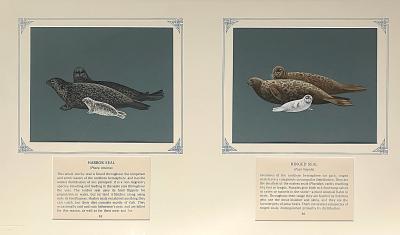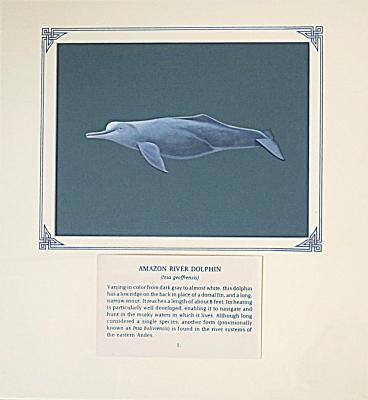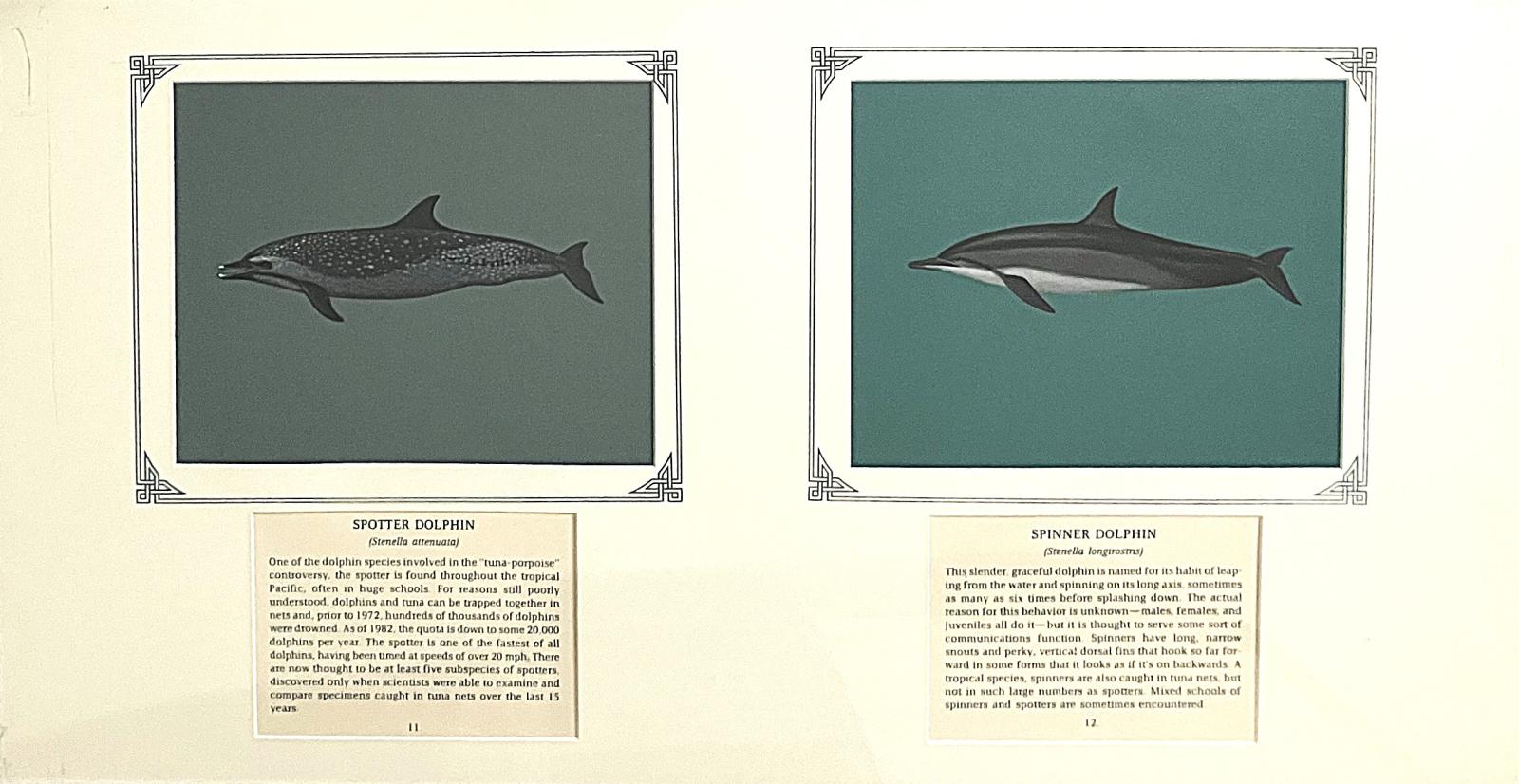PAINTINGS - SPOTTER DOLPHIN (11) & SPINNER DOLPHIN (12)
c. 1975Painting of dolphins (a) Spotter Dolphin - White spotted, with dark grey cape from the dorsal fin to tail, lighter gray side and underbelly, and long, slender, white-tipped beak (11.) b) Spinner Dolphin - Slender with a dark gray dorsal cape, light gray sides, white underbelly, and long beak (12.); gouache on blue card, framed and mounted with inscription.
Collection of 106 of paintings by Richard Ellis that were selected by the Smithsonian Institution to form a traveling exhibit of the marine mammals of the world. The collection was purchased by Perth businessman Kevin Parry in 1985 and donated to Whale World, now known as Albany's Historic Whaling Station.
Details
Details
SPOTTER DOLPHIN (Stenella attenuata)
One of the dolphin species involved in the "tuna-porpoise" controversy, the spotter is found throughout the tropical Pacific, often in huge schools. For reasons still poorly understood, dolphins and tuna can be trapped together in nets and, prior to 1972, hundreds of thousands of dolphins were drowned. As of 1982, the quota is down to some 20,000 dolphins per year. The spotter is one of the fastest of all dolphins, having been timed at speeds of over 20mph. There are now thought to be at least fie subspecies of spotters, discovered only when scientists were able to examine and compare specimens caught in tuna nets over the last 15 years.
11.
SPINNER DOLPHIN (Stenella longirostris)
This slender, graceful dolphin is named for its habit of leaping from the water and spinning on its long axis, sometimes as many as six times before splashing down. The actual reason for this behavior is unknown-males, females, and juveniles all do it - but it is thought to serve some sort of communications function. spinners have long, narrow snouts and perky, vertical dorsal fins that hook so far forward in some forms that it looks as if it's on backwards. A tropical species, spinners are also caught in tuna nets, but not in such large numbers as spotters. Mixed schools of spinners and spotters are sometimes encountered.
12.
Verso Smithsonian label checklist # 11, 12, Packing case c.1) Reframed RE1999.316(a) (b) No longer anything on verso.
The paintings represent a body of work by well-known American marine conservationist, author, artist and natural historian Richard Ellis (1938-2024).
Copyright and Reference
Copyright and Reference
Albany's Historic Whaling Station
Albany's Historic Whaling Station
Other items by Richard Ellis
- PAINTINGS - (a)Longfin Pilot Whale (b)Shortfin Pilot Whale
- PAINTING -NORTHERN FUR SEAL
- PAINTINGS - (a) HARBOR PORPOISE (b) VAQUITA
- PAINTINGS - (a) FIN WHALE & (b)BLUE WHALE
- PAINTING - CARIBEAN MANATEE
- PAINTING - (a) HARBOR SEAL, (b) RINGED SEAL
- PAINTING - DALL PORPOISE
- PRINT -HUMBACK WHALE AND SPINNER DOLPHINS- PUBLISHER PROOF 4/20
- PAINTINGS - (a) DUSKY DOLPHIN & (b) PEALE'S DOLPHIN
- PAINTING - SOUTHERN LION SEAL
- PAINTING - BAIKAL SEAL
- PAINTING - FRANCISCANA
More items like this
- PAINTING - STRIPED DOLPHIN
- PAINTINGS - (a)FRASER'S DOLPHIN & (b)WHITE BEAKED DOLPHIN
- PAINTINGS (a) NORTHERN RIGHT DOLPHIN (b)SOUTHERN RIGHT DOLPHIN
- PAINTING - (a) INDO-PACIFIC HUMPBACK DOLPHIN & (b) ROUGH-TOOTHED DOLPHIN
- PAINTING - COMMERSON'S DOLPHIN
- PAINTING - RISSO'S DOLPHIN
- PAINTING - HEAVISIDE'S DOLPHIN
- PAINTING - HOURGLASS DOLPHIN
Other items from Albany's Historic Whaling Station
- PAINTING - AMAZON RIVER DOLPHIN
- PAINTING - DENSE-BEAKED WHALE
- PAINTING - GRAY WHALE
- PAINTINGS - (a)PYGMY SPERM WHALE (b)DWARF SPERM WHALE
- PAINTING - SOWERBY`S BEAKED WHALE
- PAINTING -PYGMY KILLER WHALE
- PAINTINGS - (a)TRUE'S BEAKED WHALE (b) GULFSTREAM BEAKED WHALE
- PAINTINGS - (a) RIGHT WHALE & (b) BOWHEAD WHALE
- PAINTING - HUMPBACK WHALE
- PAINTING - SPERM WHALE
- PAINTING - PYGMY RIGHT WHALE
- PAINTINGS - (a) MINKE WHALE & (b) BRYDE'S WHALE



